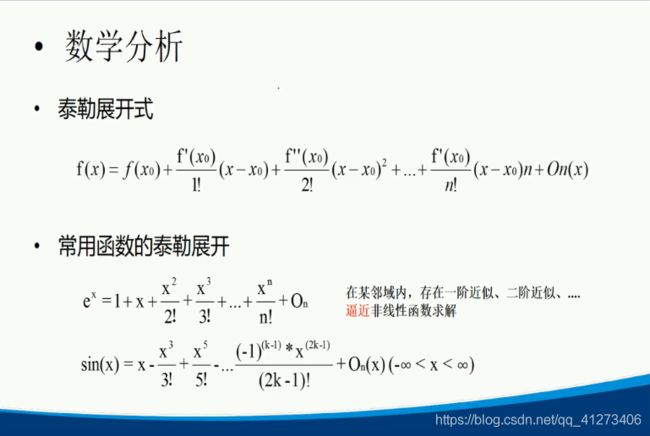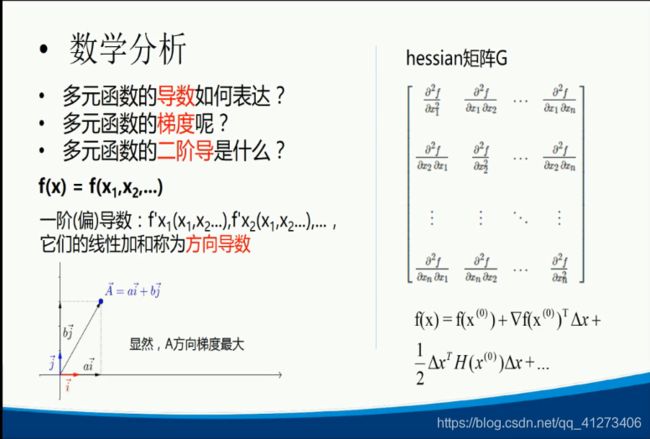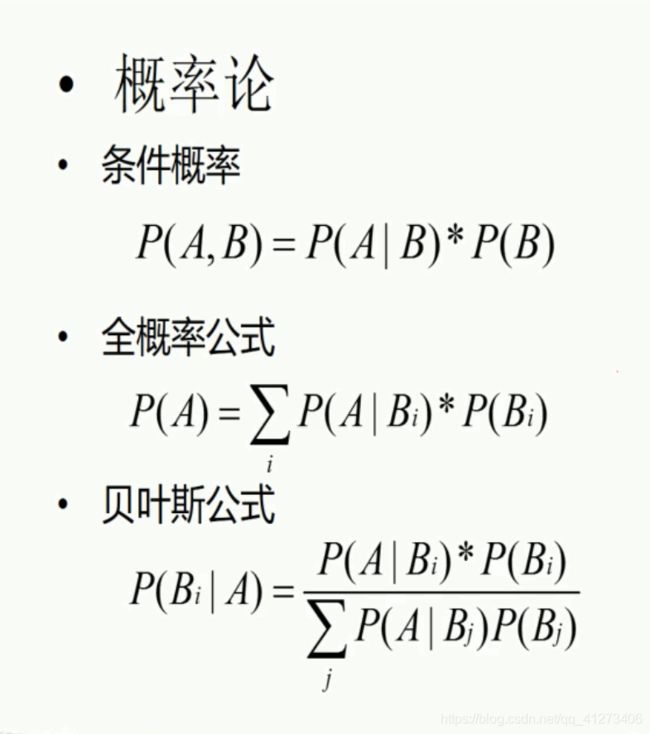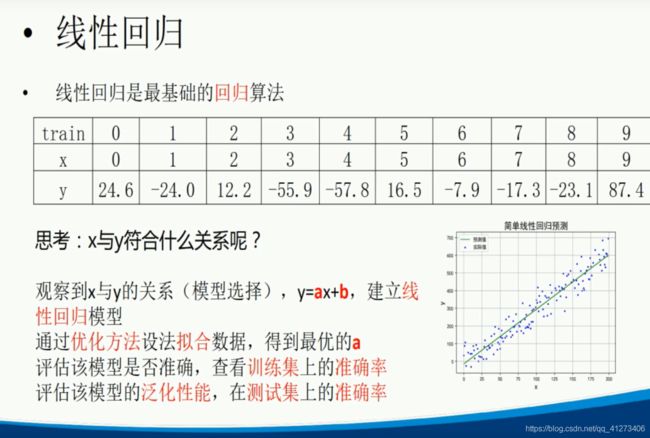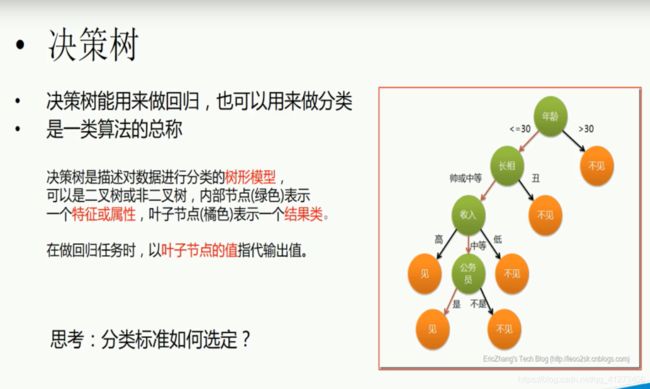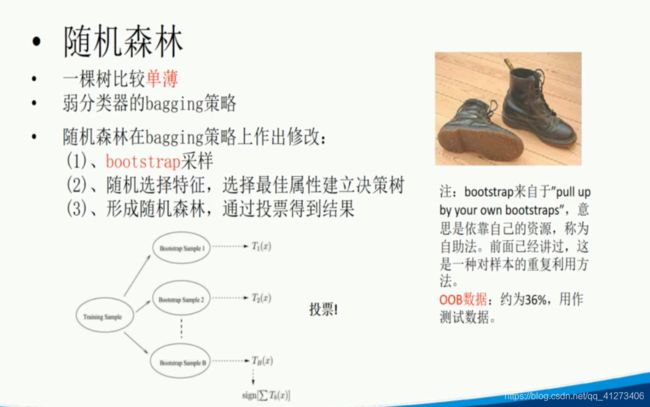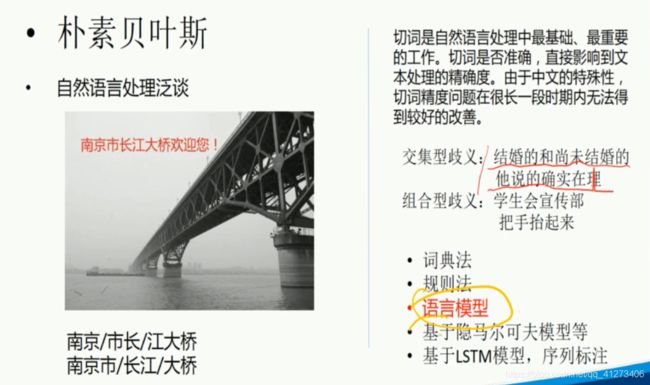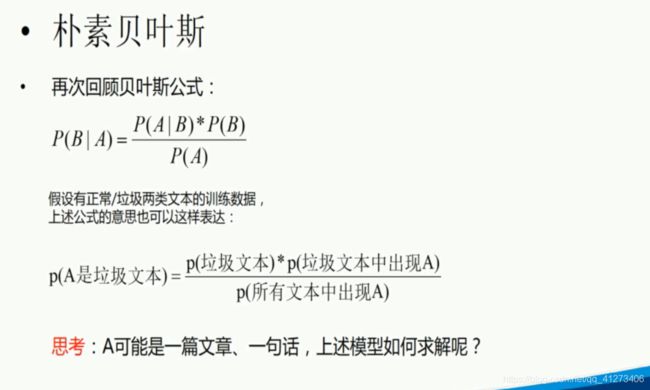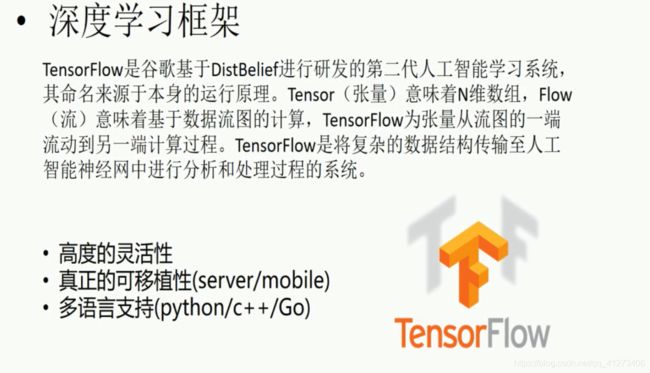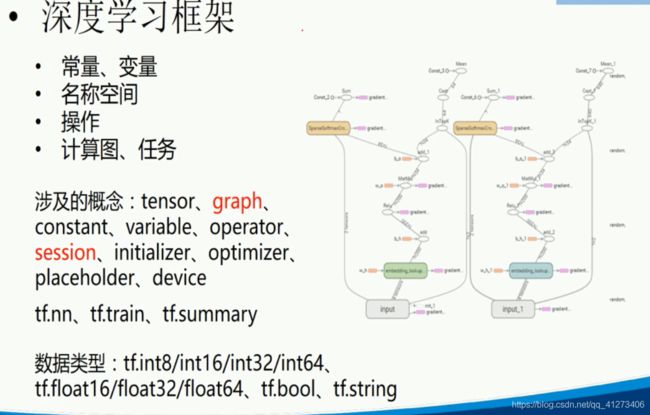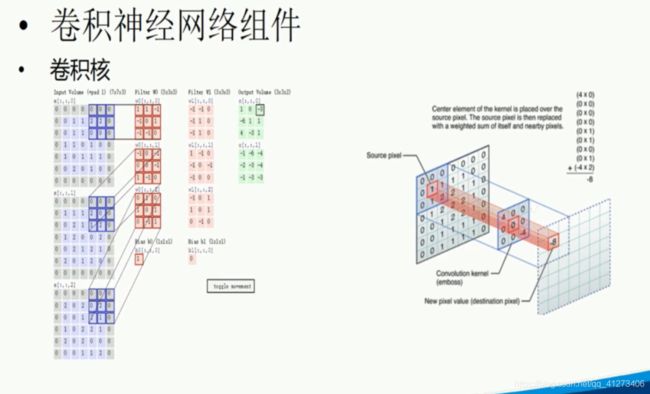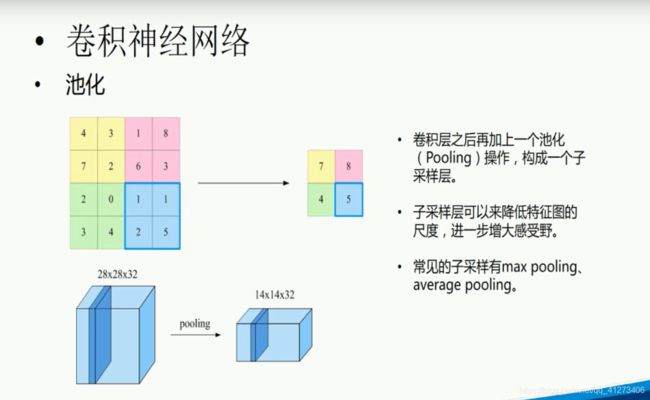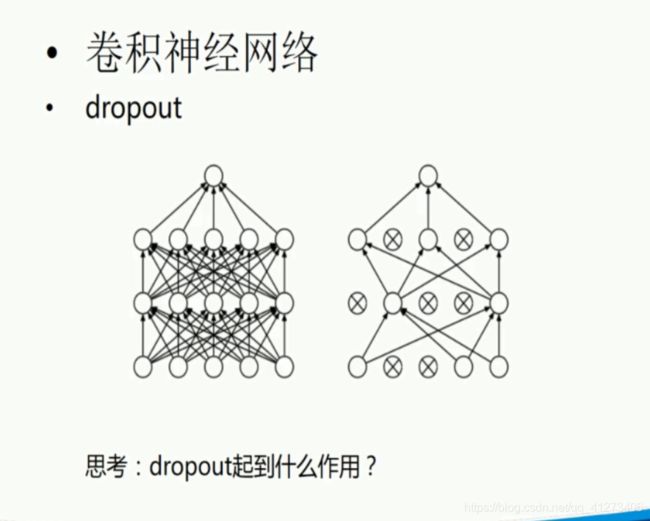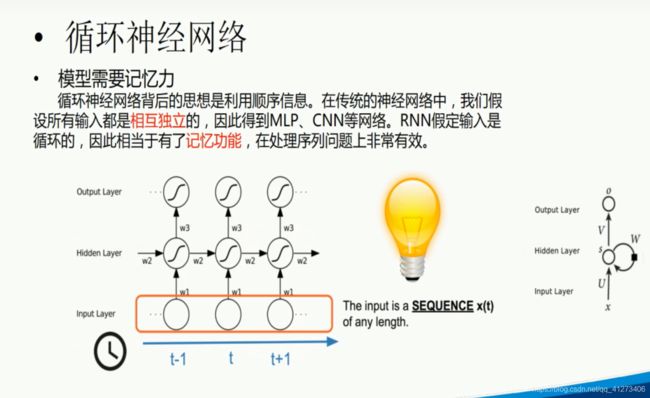尚硅谷-机器学习与深度学习笔记
本文章仅仅记录本人的学习过程,侵权删。
视频地址:https://www.bilibili.com/video/BV1zb411P7iV
代码和数据:代码和数据
P3. 人工智能的发展和现状
什么是人工智能:
人工智能(Artificial Intelligence) ,英文缩写:AI 。它是研究,开发用于模拟、延伸和扩展人的智能的理论、方法、技术及应用系统的一门新的技术科学。人工智能是计算机科学的一个分支,它试图了解智能的实质,并生产出一种新的能以人类智能相识的方式作出反应的智能机器。
应用场景:
- 机器人
- 语音识别
- 图像识别
- 自然语言处理
- 专家系统
- 知识工程
- 机器学习
人工智能是对人的意识,思维的信息过程的模拟。人工智能不是人的智能,但能像人那样的思考,甚至超过人的智能。
P4.数学分析基础
P5. 线性代数与概率论基础
P6.机器学习基本概念
从学习的方式上分为:
- 监督学习
- 无监督学习
- 半监督学习
- 强化学习
从学习结果上分为:
- 回归
- 分类
P7.线性回归模型
P8.线性回归习题与总结
import numpy as np
import pandas as pd
import matplotlib as mpl
import matplotlib.pyplot as plt
from sklearn.model_selection import train_test_split
from sklearn.linear_model import LinearRegression
from sklearn.linear_model import Lasso
from sklearn.linear_model import Ridge
from sklearn.linear_model import ElasticNet
from sklearn.preprocessing import PolynomialFeatures, StandardScaler
from sklearn.pipeline import Pipeline
def generate_lr_train_data(polynomial = False):
if not polynomial:
f = open("./simple_lr.data", "w")
for i in range(200):
f.write("%s %s\n" % (i, i * 3 + np.random.normal(0, 50)))
else:
f = open("./polynomial_lr.data", "w")
for i in range(200):
f.write("%s %s\n" % (i, 1 / 20 * i * i + i + np.random.normal(0, 80)))
f.close()
def read_lr_train_data(polynomial = False):
if not polynomial:
return pd.read_csv("./simple_lr.data", header = None)
else:
return pd.read_csv("./polynomial_lr.data", header = None)
def simple_linear_regression():
# if polynomial used
polynomial = True
# generate simple lr train data
generate_lr_train_data(polynomial)
# read simple lr train data 读取数据
lr_data = read_lr_train_data(polynomial)
clean_data = np.empty((len(lr_data), 2))
for i, d in enumerate(lr_data.values):#数据清洗,去除重复行
clean_data[i] = list(map(float, list(d[0].split(' '))))
x, y = np.split(clean_data, (1, ), axis = 1) # split array to shape [:1],[1:] 切割
y = y.ravel()
print("样本个数:%d,特征个数:%d" % x.shape)
#划分训练集和测试集
x_train, x_test, y_train, y_test = train_test_split(x, y, train_size = 0.7, random_state = 0)
model = Pipeline([("ss", StandardScaler()),
("polynomial", PolynomialFeatures(degree = 60, include_bias = True)),#升幂
#("linear", Lasso(alpha=10))
("linear", LinearRegression()) # 这里可以在选择普通线性回归、Lasso/Ridge
])
print("开始建模")
model.fit(x_train, y_train)
y_pred = model.predict(x_train)
print("建模完毕")
# 绘制前调整数据
order = x_train.argsort(axis=0).ravel()
x_train = x_train[order]
y_train = y_train[order]
y_pred = y_pred[order]
# 绘制拟合曲线
mpl.rcParams["font.sans-serif"] = ["simHei"]
mpl.rcParams["axes.unicode_minus"] = False
plt.figure(facecolor = "w", dpi = 200)
plt.scatter(x_train, y_train, s = 5, c = "b", label = "实际值")
plt.plot(x_train, y_pred, "g-", lw = 1, label = "预测值")
plt.legend(loc="best")
plt.title("简单线性回归预测", fontsize=18)
plt.xlabel("x", fontsize=15)
plt.ylabel("y", fontsize=15)
plt.grid()
plt.show()
if __name__ == "__main__":
simple_linear_regression()
用(“linear”, Lasso(alpha=10))产生的:

用(“linear”, LinearRegression())产生的:
P9.Logistic回归模型与练习
import numpy as np
import pandas as pd
from sklearn.linear_model import LogisticRegression
from sklearn.preprocessing import StandardScaler, PolynomialFeatures
from sklearn.pipeline import Pipeline
import matplotlib as mpl
import matplotlib.pyplot as plt
if __name__ == "__main__":
path = 'iris.data'
data = pd.read_csv(path, header=None)
data[4] = pd.Categorical(data[4]).codes # one-hot 类似特征矩阵 有就是1,没有就是0
print(data[4].unique())
x, y = np.split(data.values, (4,), axis=1)
x = x[:, :2]
lr = Pipeline([('sc', StandardScaler()), ('poly', PolynomialFeatures(degree=2)), ('clf', LogisticRegression())])
lr.fit(x, y.ravel())
y_hat = lr.predict(x)
y_hat_prob = lr.predict_proba(x)
np.set_printoptions(suppress=True)
print('y_hat = \n', y_hat)
print('y_hat_prob = \n', y_hat_prob)
print('准确率:%.2f%%' % (100 * np.mean(y_hat == y.ravel())))
# 画图
N, M = 500, 500 # 横纵各采样多少个值
x1_min, x1_max = x[:, 0].min(), x[:, 0].max() # 第0列的范围
x2_min, x2_max = x[:, 1].min(), x[:, 1].max() # 第1列的范围
t1 = np.linspace(x1_min, x1_max, N)
t2 = np.linspace(x2_min, x2_max, M)
x1, x2 = np.meshgrid(t1, t2) # 生成网格采样点
x_test = np.stack((x1.flat, x2.flat), axis=1) # 测试点
mpl.rcParams['font.sans-serif'] = ['simHei']
mpl.rcParams['axes.unicode_minus'] = False
y_hat = lr.predict(x_test) # 预测值
y_hat = y_hat.reshape(x1.shape) # 使之与输入的形状相同
plt.figure(facecolor='w')
plt.pcolormesh(x1, x2, y_hat) # 预测值的显示
plt.scatter(x[:, 0], x[:, 1], c=np.squeeze(y), s=50) # 样本的显示
plt.xlabel('花萼长度', fontsize=14)
plt.ylabel('花萼宽度', fontsize=14)
plt.xlim(x1_min, x1_max)
plt.ylim(x2_min, x2_max)
plt.grid()
plt.title("Logistic回归-鸢尾花", fontsize=17)
plt.show()
P10.决策树
P11.随机森林
import numpy as np
import pandas as pd
import xgboost as xgb
from sklearn.model_selection import train_test_split # cross_validation
def iris_type(s):
it = {b'Iris-setosa': 0, b'Iris-versicolor': 1, b'Iris-virginica': 2}
return it[s]
if __name__ == "__main__":
path = 'iris.data' # 数据文件路径
data = np.loadtxt(path, dtype=float, delimiter=',', converters={4: iris_type})
data = pd.read_csv(path, header=None)
x, y = data[list(range(4))], data[4]
y = pd.Categorical(y).codes
x_train, x_test, y_train, y_test = train_test_split(x, y, random_state=1, test_size=50)
data_train = xgb.DMatrix(x_train, label=y_train)
data_test = xgb.DMatrix(x_test, label=y_test)
watch_list = [(data_test, 'eval'), (data_train, 'train')]
param = {'max_depth': 2, 'eta': 0.3, 'silent': 1, 'objective': 'multi:softmax', 'num_class': 3}
bst = xgb.train(param, data_train, num_boost_round=6, evals=watch_list)
y_hat = bst.predict(data_test)
result = y_test.reshape(1, -1) == y_hat
print('正确率:\t', float(np.sum(result)) / len(y_hat))
P12.朴素贝叶斯
import numpy as np
from sklearn.naive_bayes import MultinomialNB, BernoulliNB
from sklearn.datasets import fetch_20newsgroups
from sklearn.feature_extraction.text import TfidfVectorizer
from sklearn.model_selection import GridSearchCV
from sklearn import metrics
from time import time
from pprint import pprint
import matplotlib.pyplot as plt
import matplotlib as mpl
def make_test(classfier):
print('分类器:', classfier)
alpha_can = np.logspace(-3, 2, 10)
model = GridSearchCV(classfier, param_grid={'alpha': alpha_can}, cv=5)
model.set_params(param_grid={'alpha': alpha_can})
t_start = time()
model.fit(x_train, y_train)
t_end = time()
t_train = (t_end - t_start) / (5 * alpha_can.size)
print('5折交叉验证的训练时间为:%.3f秒/(5*%d)=%.3f秒' % ((t_end - t_start), alpha_can.size, t_train))
print('最优超参数为:', model.best_params_)
t_start = time()
y_hat = model.predict(x_test)
t_end = time()
t_test = t_end - t_start
print('测试时间:%.3f秒' % t_test)
acc = metrics.accuracy_score(y_test, y_hat)
print('测试集准确率:%.2f%%' % (100 * acc))
name = str(classfier).split('(')[0]
index = name.find('Classifier')
if index != -1:
name = name[:index]
return t_train, t_test, 1 - acc, name
if __name__ == "__main__":
remove = ('headers', 'footers', 'quotes')
categories = 'alt.atheism', 'talk.religion.misc', 'comp.graphics', 'sci.space' # 选择四个类别进行分类
# 下载数据
data_train = fetch_20newsgroups(subset='train', categories=categories, shuffle=True, random_state=0, remove=remove)
data_test = fetch_20newsgroups(subset='test', categories=categories, shuffle=True, random_state=0, remove=remove)
print('训练集包含的文本数目:', len(data_train.data))
print('测试集包含的文本数目:', len(data_test.data))
print('训练集和测试集使用的%d个类别的名称:' % len(categories))
categories = data_train.target_names
pprint(categories)
y_train = data_train.target
y_test = data_test.target
print(' -- 前10个文本 -- ')
for i in np.arange(10):
print('文本%d(属于类别 - %s):' % (i + 1, categories[y_train[i]]))
print(data_train.data[i])
print('\n\n')
# tf-idf处理
vectorizer = TfidfVectorizer(input='content', stop_words='english', max_df=0.5, sublinear_tf=True)
x_train = vectorizer.fit_transform(data_train.data)
x_test = vectorizer.transform(data_test.data)
print('训练集样本个数:%d,特征个数:%d' % x_train.shape)
print('停止词:\n', end=' ')
#pprint(vectorizer.get_stop_words())
feature_names = np.asarray(vectorizer.get_feature_names())
# 比较分类器结果
clfs = (MultinomialNB(), BernoulliNB())
result = []
for clf in clfs:
r = make_test(clf)
result.append(r)
print('\n')
result = np.array(result)
time_train, time_test, err, names = result.T
time_train = time_train.astype(np.float)
time_test = time_test.astype(np.float)
err = err.astype(np.float)
x = np.arange(len(time_train))
mpl.rcParams['font.sans-serif'] = ['simHei']
mpl.rcParams['axes.unicode_minus'] = False
plt.figure(figsize=(10, 7), facecolor='w')
ax = plt.axes()
b1 = ax.bar(x, err, width=0.25, color='#77E0A0')
ax_t = ax.twinx()
b2 = ax_t.bar(x + 0.25, time_train, width=0.25, color='#FFA0A0')
b3 = ax_t.bar(x + 0.5, time_test, width=0.25, color='#FF8080')
plt.xticks(x + 0.5, names)
plt.legend([b1[0], b2[0], b3[0]], ('错误率', '训练时间', '测试时间'), loc='upper left', shadow=True)
plt.title('新闻组文本数据不同分类器间的比较', fontsize=18)
plt.xlabel('分类器名称')
plt.grid(True)
plt.tight_layout(2)
plt.show()
P13.深度学习背景及简介
P14.深度神经网络基础及DNN简介
P15.Tensorflow框架简介
P16.Tensorflow入门示例
import tensorflow as tf
import numpy as np
tf.compat.v1.disable_eager_execution()#非常重要
# 用 NumPy 随机生成 100 个数据
x_data = np.float32(np.random.rand(2, 100))
y_data = np.dot([0.100, 0.200], x_data) + 0.300
# 构造一个线性模型
b = tf.Variable(tf.zeros([1]))
W = tf.Variable(tf.random.uniform([1, 2], -1.0, 1.0))
y = tf.matmul(W, x_data) + b
# 最小化方差
loss = tf.reduce_mean(tf.square(y - y_data)) #平均方差
optimizer = tf.compat.v1.train.GradientDescentOptimizer(0.5)#优化器0.5步长
train = optimizer.minimize(loss)
# 初始化变量
init = tf.compat.v1.global_variables_initializer()
# 启动图 (graph)
sess = tf.compat.v1.Session()
sess.run(init)
# 拟合平面
for step in range(0, 201):
l, _ = sess.run([loss, train])
print(l)
w_result, b_result = sess.run([W, b])
print(w_result, b_result)
for step in range(0, 201):
sess.run(train)
if step % 20 == 0:
print(step, sess.run(W), sess.run(b))
因为源码当时的tf版本和现在的版本不同出了一些错误,其中一些小改一下就好了,
但是其中有一个非常坑,找了好久才解决。
地址:https://blog.csdn.net/qq_41273406/article/details/117969984
P17.卷积神经网络
P18.卷积神经网络代码
这个是课件上的代码,因为版本不同没有运行成功。后面有我自己找到的代码。
from PIL import Image
import tensorflow as tf
from tensorflow.examples.tutorials.mnist import input_data
mnist = input_data.read_data_sets('./MNIST_data', one_hot=True)
# 定义图
x = tf.placeholder(tf.float32, shape=[None, 784]) #接收图像
y_ = tf.placeholder(tf.float32, shape=[None, 10]) #接收标签
x_image = tf.reshape(x, [-1, 28, 28, 1])
#卷积
W_conv1 = tf.Variable(tf.truncated_normal([5, 5, 1, 32], stddev=0.1))#5*5的卷积核,出口1,数量32
b_conv1 = tf.constant(0.1, shape=[32])
h_conv1 = tf.nn.relu(tf.nn.conv2d(x_image, W_conv1, strides=[1, 1, 1, 1], padding='SAME') + b_conv1)#激活函数
h_pool1 = tf.nn.max_pool(h_conv1, ksize=[1, 2, 2, 1], strides=[1, 2, 2, 1], padding='SAME')#池化
#
W_conv2 = tf.Variable(tf.truncated_normal([5, 5, 32, 64], stddev=0.1))
b_conv2 = tf.constant(0.1, shape=[64])
h_conv2 = tf.nn.relu(tf.nn.conv2d(h_pool1, W_conv2, strides=[1, 1, 1, 1], padding='SAME') + b_conv2)
h_pool2 = tf.nn.max_pool(h_conv2, ksize=[1, 2, 2, 1], strides=[1, 2, 2, 1], padding='SAME')
#
W_fc1 = tf.Variable(tf.truncated_normal([7 * 7 * 64, 1024], stddev=0.1))
b_fc1 = tf.constant(0.1, shape=[1024])
h_pool2 = tf.reshape(h_pool2, [-1, 7 * 7 * 64])
h_fc1 = tf.nn.relu(tf.matmul(h_pool2, W_fc1) + b_fc1)
keep_prob = tf.placeholder(tf.float32)
h_fc1 = tf.nn.dropout(h_fc1, keep_prob)
W_fc2 = tf.Variable(tf.truncated_normal([1024, 10], stddev=0.1))
b_fc2 = tf.constant(0.1, shape=[10])
y_conv = tf.matmul(h_fc1, W_fc2) + b_fc2
cross_entropy = tf.reduce_mean(tf.nn.softmax_cross_entropy_with_logits(labels=y_, logits=y_conv))
train_step = tf.train.AdamOptimizer(1e-4).minimize(cross_entropy)
correct_prediction = tf.equal(tf.argmax(y_conv, 1), tf.argmax(y_, 1))
prediction = tf.argmax(y_conv, 1)
accuracy = tf.reduce_mean(tf.cast(correct_prediction, tf.float32))
saver = tf.train.Saver() # defaults to saving all variables
process_train = False
with tf.Session() as sess:
if process_train:
sess.run(tf.global_variables_initializer())
for i in range(20000):
batch = mnist.train.next_batch(100)
_, train_accuracy = sess.run([train_step, accuracy],
feed_dict={x: batch[0], y_: batch[1], keep_prob: 0.5})
if i % 100 == 0:
print("step %d, training accuracy %g" % (i, train_accuracy))
# 保存模型参数,注意把这里改为自己的路径
saver.save(sess, './mnist_model/model.ckpt')
print("test accuracy %g" % accuracy.eval(feed_dict={x: mnist.test.images,
y_: mnist.test.labels, keep_prob: 1.0}))
else:
saver.restore(sess, "./mnist_model/model.ckpt")
pred_file = "./3.png"
img_content = Image.open(pred_file)
img_content = img_content.resize([28, 28])
pred_content = img_content.convert("1")
pred_pixel = list(pred_content.getdata()) # get pixel values
pred_pixel = [(255 - x) * 1.0 / 255.0 for x in pred_pixel]
pred_num = sess.run(prediction, feed_dict={x: [pred_pixel], keep_prob: 1.0})
print('recognize result:')
print(pred_num)
可以运行成功的代码:
https://blog.csdn.net/qq_41273406/article/details/117998232
P19.Word EMbedding模型
P20.循环神经网络 1
P21.循环神经网络2
P22.循环神经网络应用
23.聊天机器人实战
代码在开头链接中,这个没实现我太菜了。

